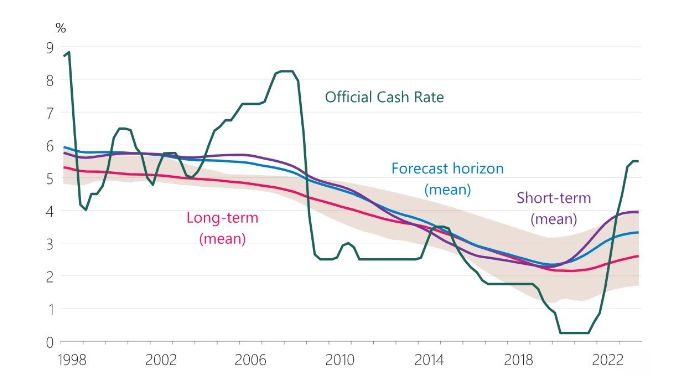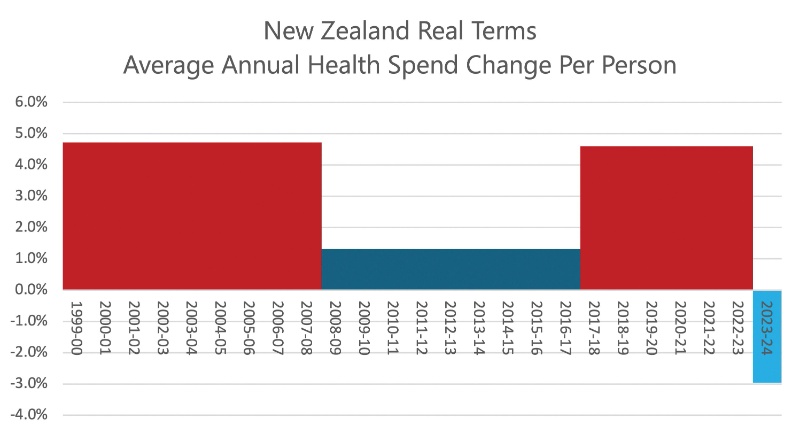Finding Neutral: Estimates Of New Zealand’s Nominal Neutral Interest Rate
Due to New Zealanders’ high inflation expectations, the Official Cash Rate (OCR) would currently need to be about 3.9 percent to neither tap the brakes nor push on the accelerator of the economy, the Reserve Bank’s new Bulletin article shows. The current OCR – at 5.5 percent – is reducing capacity pressures and inflation in New Zealand.
Read Bulletin
This Bulletin article explains how we construct, use, and think about indicators for the neutral interest rate (NIR) at Te Pūtea Matua - the Reserve Bank of New Zealand (RBNZ).
When an investor considers their return on an investment, they are not merely interested in how many dollars they will receive in the future, but also how many goods and services they can purchase with those dollars. Therefore, their real rate of return can be calculated by subtracting expected future inflation from the nominal interest rate they invested at.
Likewise, it is the real NIR – the nominal NIR adjusted for inflation expectations – that matters for spending and investment decisions. However, the OCR is in nominal terms. So, to assess the stance of monetary policy, we need to adjust the real NIR for expected future inflation - from the short term, out to 10 years – to get an estimate of the nominal NIR.
Currently, with elevated inflation expectations, the “neutral” OCR is around 3.9 percent – our average short-term nominal NIR. This compares with the actual OCR of 5.5 per cent, which is therefore clearly contractionary.
As inflation expectations continue to decline, a lower OCR would be considered a “neutral” rate. For example, our average of 5 different real NIR estimates adjusted to an average long-term nominal NIR suggest that an OCR of 2.5 percent would be neutral.
The OCR (green line) is reducing
inflation in New Zealand.
Figure 4: The nominal
NIR estimates over different horizons

Our suite of real NIR indicators covers a range of different conceptual approaches to estimating the NIR, as well as utilising different data sources and techniques.
“The conceptual complexity and inherent uncertainty in estimating the NIR means we cannot rely on any single estimate of the NIR for New Zealand” two of the Bulletin authors Andre Castaing and Marea Sing say.
“A simple average of these estimates serves as a guide for our core forecasting and modelling process, but different uses may justify different approaches, and expert judgement is needed to ensure the models are put to their best use,” they say.
“While our indicator suite suggests a long-term NIR of around 2.5 percent, interest rates currently need to be substantially higher in the short- to medium-term to exert downwards pressure on economic activity,” the Bulletin says.
More information:
Estimates of New Zealand’s Nominal Neutral Interest Rate.
Authors: Andre Castaing, Meltem Chadwick, Jaqueson K. Galimberti, Marea Sing and Evelyn Truong
Andre Castaing gives a summary of his rese.arch and key findings


 Gordon Campbell: On The Americanising Of NZ’s Public Health System
Gordon Campbell: On The Americanising Of NZ’s Public Health System PSA: 1000 Days Since Landmark Pay Equity Deal Expired - Workers Losing $145 A Week
PSA: 1000 Days Since Landmark Pay Equity Deal Expired - Workers Losing $145 A Week Grace Tinetali-Fiavaai, RNZ: Widow Of Fa'anānā Efeso Collins Seeks Inquiry Into His Death - 'Unanswered Questions'
Grace Tinetali-Fiavaai, RNZ: Widow Of Fa'anānā Efeso Collins Seeks Inquiry Into His Death - 'Unanswered Questions' Te Pāti Māori: Te Pāti Māori Call For Mandatory Police Body Cameras
Te Pāti Māori: Te Pāti Māori Call For Mandatory Police Body Cameras NZ First Party: NZ First Introduces the “Conscience Acts Referendums Bill”
NZ First Party: NZ First Introduces the “Conscience Acts Referendums Bill” NZ Government: Unlocking Data To Increase Competition And Choice
NZ Government: Unlocking Data To Increase Competition And Choice Lawyers for Climate Action: National MP’s Bill Raises Environmental And Constitutional Concerns
Lawyers for Climate Action: National MP’s Bill Raises Environmental And Constitutional Concerns


